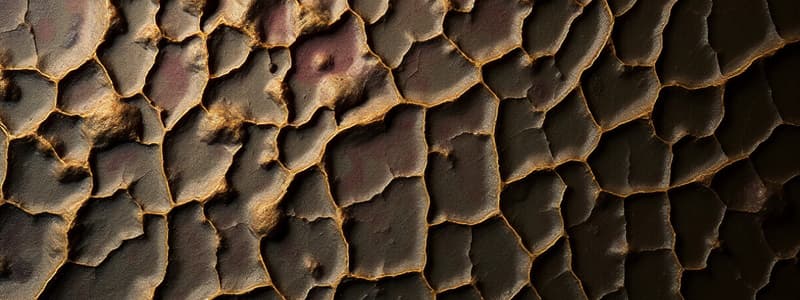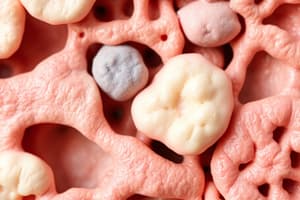Podcast
Questions and Answers
What is the primary characteristic of elastic fibers in connective tissue?
What is the primary characteristic of elastic fibers in connective tissue?
- They form a rigid network for support.
- They are thicker than collagen fibers.
- They can be stretched up to 150% of their relaxed length. (correct)
- They are primarily composed of collagen.
Which statement accurately describes reticular fibers?
Which statement accurately describes reticular fibers?
- They consist of collagen in fine branching bundles coated in glycoproteins. (correct)
- They primarily compose the extracellular matrix of bone tissue.
- They have a linear arrangement that offers resistance to pulling forces.
- They are thicker than collagen and provide minimal support.
What important role does collagen play in cartilage compared to bone?
What important role does collagen play in cartilage compared to bone?
- It attracts more water, offering cushioning properties. (correct)
- It is less abundant in cartilage than in bone.
- It provides greater rigidity in cartilage than in bone.
- It allows cartilage to resist all forms of stress.
Which connective tissue fiber type is primarily associated with skin and blood vessel walls?
Which connective tissue fiber type is primarily associated with skin and blood vessel walls?
In which connective tissue is the orientation of collagen fibers crucially dependent on the direction of stress?
In which connective tissue is the orientation of collagen fibers crucially dependent on the direction of stress?
What is the primary function of connective tissue in the human body?
What is the primary function of connective tissue in the human body?
Which statement best characterizes the extracellular matrix of connective tissue?
Which statement best characterizes the extracellular matrix of connective tissue?
Which type of cell is classified as an immature cell in connective tissue?
Which type of cell is classified as an immature cell in connective tissue?
What role do fibroblasts play in connective tissue?
What role do fibroblasts play in connective tissue?
How are mature cells in connective tissue distinguished from immature cells?
How are mature cells in connective tissue distinguished from immature cells?
Which type of connective tissue is responsible for major transport in the body?
Which type of connective tissue is responsible for major transport in the body?
What are the two main components that make up connective tissue?
What are the two main components that make up connective tissue?
Which type of connective tissue is categorized as semisolid?
Which type of connective tissue is categorized as semisolid?
Which type of cell is primarily involved in the repair of tissue by forming granulation tissue?
Which type of cell is primarily involved in the repair of tissue by forming granulation tissue?
What is the primary function of macrophages in connective tissue?
What is the primary function of macrophages in connective tissue?
Which of the following conditions does NOT describe the extracellular matrix?
Which of the following conditions does NOT describe the extracellular matrix?
What role do adhesion proteins, particularly fibronectin, play in connective tissue?
What role do adhesion proteins, particularly fibronectin, play in connective tissue?
Which cell type is most numerous in general connective tissue and is involved in the production of histamine?
Which cell type is most numerous in general connective tissue and is involved in the production of histamine?
What is a primary characteristic of adipocytes in connective tissues?
What is a primary characteristic of adipocytes in connective tissues?
Which component of the extracellular matrix is crucial for the exchange of substances between blood and cells?
Which component of the extracellular matrix is crucial for the exchange of substances between blood and cells?
Which type of connective tissue cell is involved in the immunological response?
Which type of connective tissue cell is involved in the immunological response?
Flashcards
What is a tissue?
What is a tissue?
A group of cells that share a common embryonic origin and work together to perform specialized functions.
What is connective tissue?
What is connective tissue?
The main structural building blocks of the body, including bone, cartilage, blood, and fat.
What is the extracellular matrix?
What is the extracellular matrix?
A fibrous, gel-like substance that surrounds and supports connective tissue cells. It contains protein fibers and ground substance.
What are fibroblasts, chondroblasts, and osteoblasts?
What are fibroblasts, chondroblasts, and osteoblasts?
Signup and view all the flashcards
What are mature connective tissue cells?
What are mature connective tissue cells?
Signup and view all the flashcards
What is one of the key functions of connective tissue?
What is one of the key functions of connective tissue?
Signup and view all the flashcards
What is another key function of connective tissue?
What is another key function of connective tissue?
Signup and view all the flashcards
What is another key role of connective tissue?
What is another key role of connective tissue?
Signup and view all the flashcards
Collagen
Collagen
Signup and view all the flashcards
Elastic
Elastic
Signup and view all the flashcards
Extracellular Matrix Fibers
Extracellular Matrix Fibers
Signup and view all the flashcards
Reticular
Reticular
Signup and view all the flashcards
Connective tissue
Connective tissue
Signup and view all the flashcards
Cyte
Cyte
Signup and view all the flashcards
Fibroblasts
Fibroblasts
Signup and view all the flashcards
Adipocytes / Lipocytes
Adipocytes / Lipocytes
Signup and view all the flashcards
Macrophages
Macrophages
Signup and view all the flashcards
Lymphocytes
Lymphocytes
Signup and view all the flashcards
Mast cells
Mast cells
Signup and view all the flashcards
Extracellular matrix
Extracellular matrix
Signup and view all the flashcards
Ground substance
Ground substance
Signup and view all the flashcards
Study Notes
Tissues of the Human Body: Connective Tissue
- Connective tissue is a type of biological tissue with a diverse range of structures and functions.
- It is composed of cells and extracellular matrix.
- Key features of connective tissue include the cells, fibres and intercellular substance that constitute the tissue.
- Structure and function vary across different connective tissue types.
- Locations in the body vary with structure and function of connective tissue.
Intended Learning Outcomes
- A tissue is a group of cells that share a common embryonic origin and work together to perform specialized functions.
- Tissues are classified into principal types.
- Connective tissue has distinct features.
- Connective tissue is composed of cells, fibers, and intercellular substance.
- Various types of connective tissue exhibit specific structures and functions.
- Locating each connective tissue type within the body is important.
Tissues in the Body
- The human body is composed of different tissue types, each performing specific functions.
- Tissue types include epithelial, connective, muscular, and nervous tissue.
- These distinct tissues unite to form complex structures.
Tissue Classification
- Tissues are groups of cells with a shared origin and similar functions within an organism.
- Different tissues have different properties influenced by the nature of the extracellular matrix (ECM).
- The ECM provides structural support and enables cellular communication.
Connective Tissue Overview
- Connective tissue is characterized by a large amount of extracellular matrix.
- Key elements of connective tissue are cells and extracellular matrix.
- Types of cells that are present in various tissues include fibroblasts, adipocytes, macrophages, lymphocytes, and mast cells.
Connective Tissue Functions
- Connective tissue binds, supports, and strengthens other body tissues.
- It protects and insulates internal organs.
- It divides, structures such as skeletal muscle.
- It acts as a transport system (blood).
- It stores energy reserves.
- It's a significant part of the immune response
Connective Tissue Cells
- Connective tissues have resident and fluctuating cell types.
- Resident cells include fibroblasts, adipocytes/lipocytes, and macrophages.
- Fluctuating cells such as lymphocytes, mast cells, and plasma cells contribute to the function.
Extracellular Matrix
- The extracellular matrix is the non-cellular component of connective tissue.
- The extracellular matrix comprises protein fibers and ground substance (the material between the cells).
- The extracellular matrix provides support, shape, and communication between cells.
Extracellular Matrix – Ground Substance
- Ground substance within the extracellular matrix is fluid, semifluid, gelatinous, or calcified.
- This component consists of water and large organic molecules like polysaccharides (GAGs) and proteins (proteoglycans).
Extracellular Matrix – Role of Ground Substance
- Ground substance supports cells facilitating the exchange of substances between cells and blood.
- Supporting tissue development, migration, proliferation, and metabolism.
- Acts as a mechanical barrier, and cell adhesive proteins are part of it.
Extracellular Matrix – Fibres
- Collagen, elastic, and reticular fibres form the extracellular matrix.
- Collagen fibres are strong, resist pulling forces, and provide cushioning.
- Elastic fibres provide flexibility and elasticity.
- Reticular fibres form a supportive network around cells in certain tissues.
Extracellular Matrix – Fibres – Collagen
- Collagen is a very strong fibrous protein that resists pulling forces.
- Collagen comes in several types, with varying functions.
- It's crucial for tissue elasticity and flexibility.
- Collagen is highly prevalent in bone structure.
Extracellular Matrix – Fibres – Elastic
- Elastic fibres are thinner than collagen fibres, have branching networks, and provide elasticity to tissues.
- These fibres allow the tissues to stretch and recoil to their original shape.
- Elastic fibres are abundant in skin and blood vessels.
Extracellular Matrix – Fibres – Reticular
- Reticular fibres are a component of the extracellular matrix that form a network around cells and certain tissues.
- They provide support by coating them.
- These fibres are abundant in certain tissues, such as the spleen and lymph nodes.
Classification of Connective Tissue
- The classification of connective tissue is essential for understanding its characteristics.
- Further detail about tissue types will be covered in later lectures.
- Understanding the structure, function, and location of connective tissue is crucial for distinguishing it from other types of tissues.
Studying That Suits You
Use AI to generate personalized quizzes and flashcards to suit your learning preferences.




